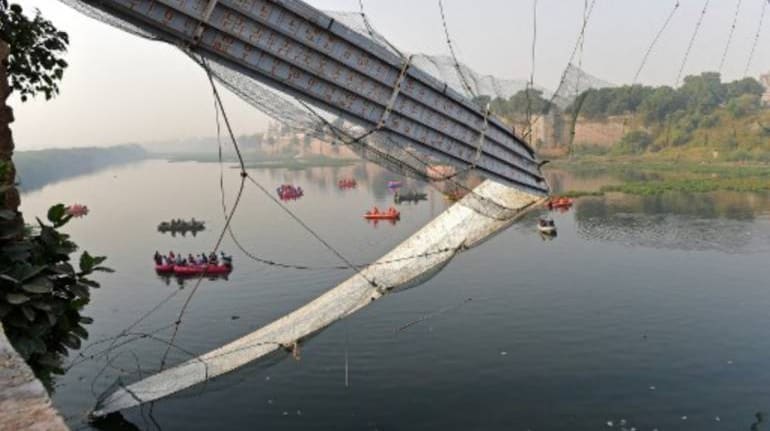



A small detail overlooked or key protocols disregarded often lies at the heart of human tragedies and accidents that lead to a loss of lives, such as the one at Morbi, in Gujarat, where the suspension bridge collapsed last week taking more than 140 lives and plunging 170 others into the Machchhu River.
From the documents and arguments presented in the court so far, astonishing as it sounds, there was an absence of fitness certification of the bridge — the Morbi municipality did not bother to regularly test the fitness of the bridge to ensure the safety of hundreds of thousands of visitors who throng it every year; it did not even mention this as a clause in the contract with the Oreva group, which maintained-and-managed it from 2008 to 2018, and secured a contract on 2022.
It should be unpardonable that, in these decades, as thousands of revellers walked on the colonial-era suspension bridge over the river, they did not know how safe – or not – it was. In fact, no one knew — not even the authorities. This is the starkest glimpse into the twin phenomena that ail India’s towns and cities: Pathetic and crumbling state of infrastructure, and a shocking deficit in urban governance. The deadly cocktail of the two together put millions of lives at risk every day – on bridges, roads, flyovers, railway crossings, tourist venues, religious places, and more.
Morbi was the latest example of the cost that Indians pay for these lapses, but it certainly (and unfortunately) is not the last. In towns and cities of India, including multi-billion metros like Mumbai and New Delhi, older infrastructure is dangerously crumbling as governments unveil new projects; this is compounded by the apathy, corruption, and chaos that goes in the name of urban governance. Think of the thousands who died on Mumbai’s roads after hitting or trying to avoid potholes, or the between 1,500 and 2,000 deaths a year.
The Morbi bridge, barely 1.25 metres wide with a span of nearly 230 metres connecting Darbargadh Palace and Lakhdhirji College, had been shut in March for repairs, and was reopened four days before its cables snapped on October 30. Considered ‘an engineering marvel’ when it was constructed nearly 140 years ago, it was promoted by the Gujarat government as a popular tourist destination. The Oreva group, which bagged the contract for repairs, is known for clocks and electrical fittings, not infrastructure construction or management; its experience was limited to maintaining the bridge from 2008 to 2018 through contractors. The company owners had told the media at the re-opening that the bridge, repaired at a cost of Rs 20 million, would be all right for the next 8-10 years, but the police told the local court last week that the contractor appointed to renovate the bridge was not qualified for the job, and there were allegedly “severe lapses in the bridge’s maintenance” which included rusted cables that were not replaced. Clearly, the disaster was waiting to happen.
Several critical questions arise about the state of infrastructure as well as urban governance: How was the company’s expertise ascertained for the renovation-repairs job, on what basis was the contract given to Oreva, on what grounds was the bridge thrown open to public without a fitness certificate, in fact why were fitness tests and certification not even considered essential? Since fitness certification was not a pre-requisite, independent tests were not carried out after the repairs, and the authorities did not force the company to shut it on October 26 in the absence of such tests. There were on-ground governance issues too: Why were people allowed on the bridge that evening in excess of its carrying capacity, why was the crowd and sale of tickets not managed to match its capacity, why was emergency life-saving equipment and rescue apparatus unavailable at such a site?
As it happens in such disasters, a few officials of the company and municipality have been arrested, and will face the long arm of law. That is as it should be, but it is not where the buck stops. The Morbi municipality’s highest officers and the company’s owners are accountable to the next of kin of the hundreds who perished that evening – and to us all – to come clean on where they cut corners and put lives of revellers at risk.
Urban governance and infrastructure management have been taken too lightly even as India’s cities and towns upgrade, and get shining new infrastructure projects; the accountability of governments and private contractors is either absent or at a bare minimum level. This cannot continue, the Morbi tragedy must motivate governments to effect the much-needed change in infrastructure management as well as in the larger urban governance framework.
Discover the latest Business News, Sensex, and Nifty updates. Obtain Personal Finance insights, tax queries, and expert opinions on Moneycontrol or download the Moneycontrol App to stay updated!
Find the best of Al News in one place, specially curated for you every weekend.
Stay on top of the latest tech trends and biggest startup news.